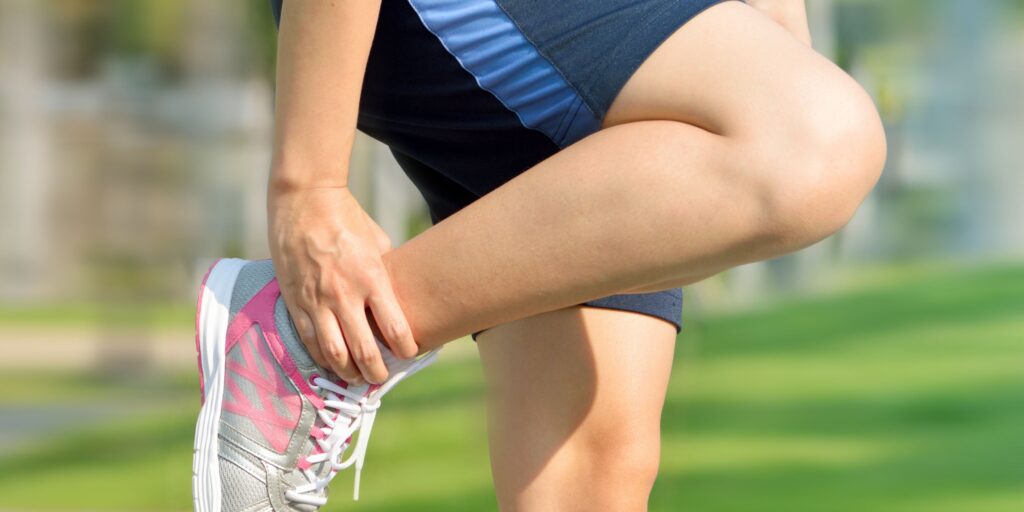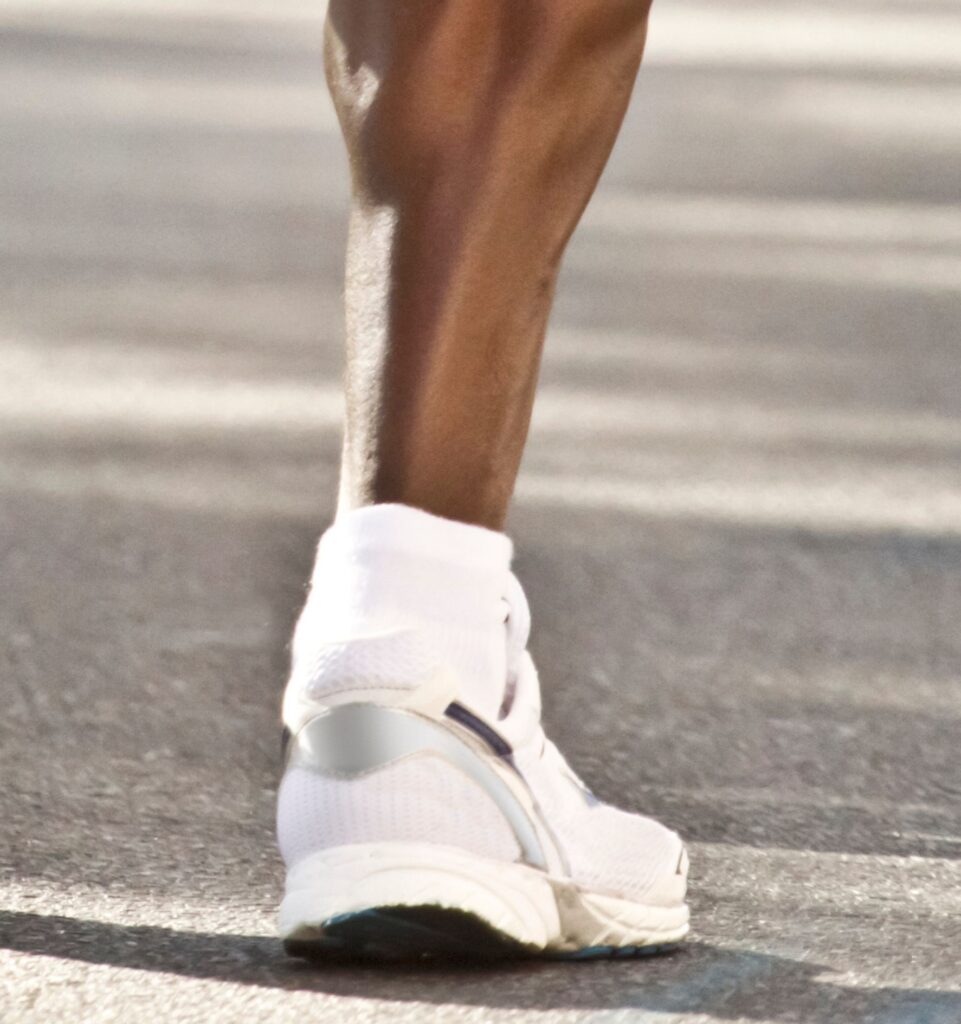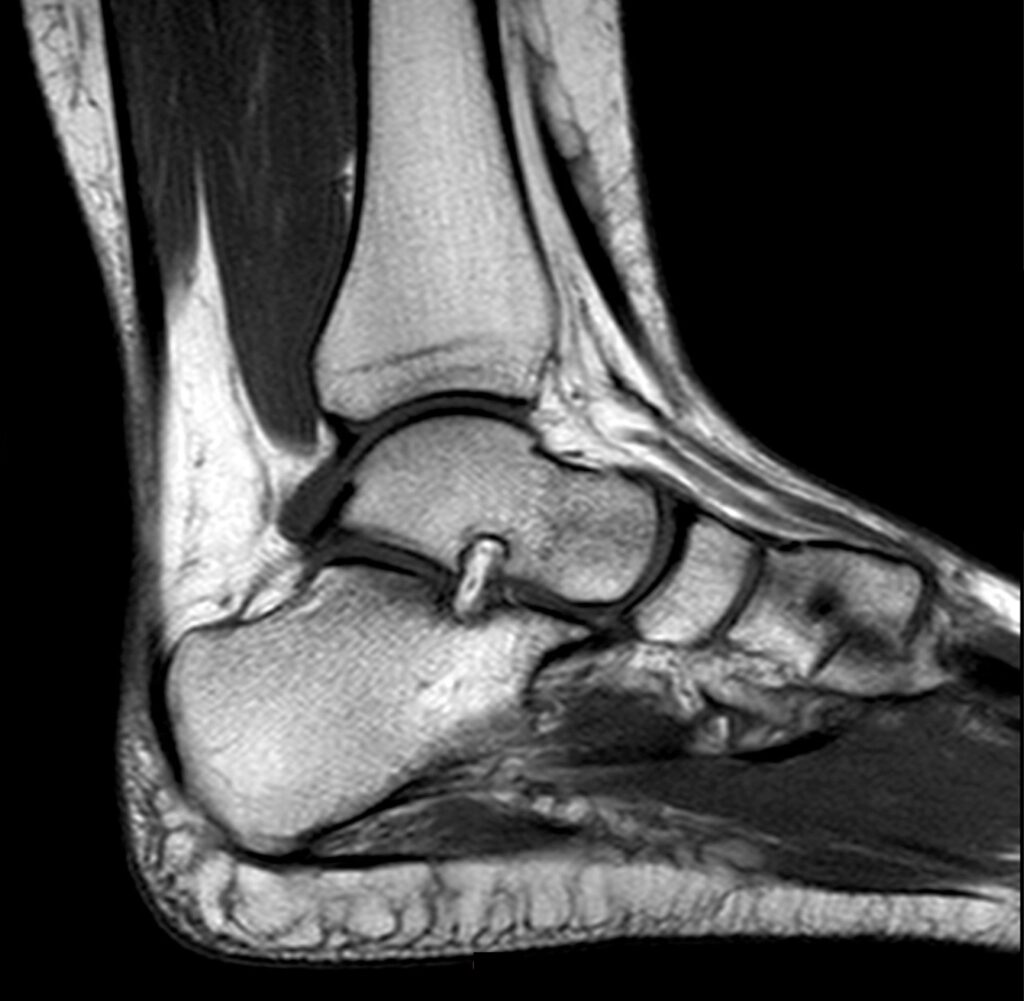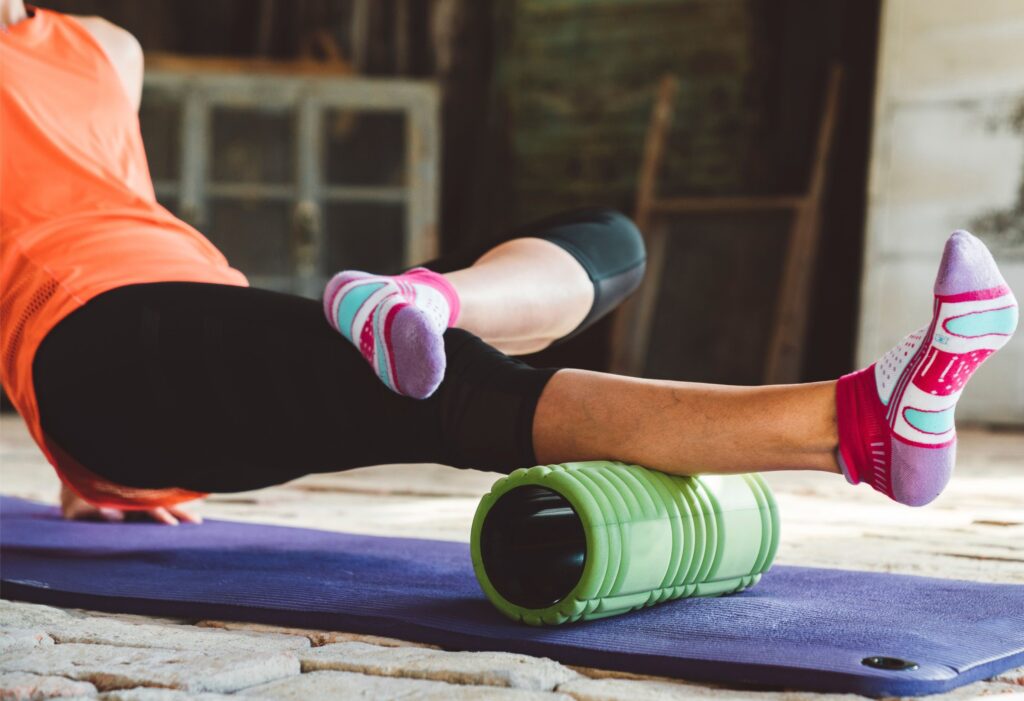
If you’re one of the many runners who are plagued by Achilles tendon pain, then you’re not alone. Achilles tendinopathy, sometimes referred to as Achilles tendinitis, is a common issue among runners and active individuals. Like many injuries, if it is managed well early it can respond well and in a reasonable time frame, but if left to become chronic it can be stubborn and take a long time to respond.
So, what does good early management of Achilles tendinopathy look like? Well, there has been a lot of research done over the last few years, and a recent article by Peter Malliaras in the Australian Journal of Physiotherapy1 gives an excellent overview of the latest findings and recommendations. So in this blog post we’ll review the main points from this article on the diagnosis of Achilles pain, and explain what it means for runners in guiding how to best manage this annoying condition.
Achilles Tendinopathy? Tendonitis Or Tendinosis? What’s The difference?
First let’s clarify the terminology. In a recent international symposium, experts reached a consensus that “Achilles tendinopathy” is the best term to describe the condition. Labels such as “tendinitis” and “tendinosis” have fallen out of favour. Why? These terms imply specific biological processes that are still debated and not well understood. For example “tendonitis” implies that there is a lot of inflammation involved however, especially in chronic Achilles pain, there is often not much inflammation at all, so to call it a tendonitis is not correct. Moreover, terms like this can incorrectly suggest that simple rest is enough for recovery, i.e. “just rest and let the inflammation settle down” is not good management, because in many cases inflammation is not a significant part of the injury. In contrast, the term “tendinopathy” is a broad term that covers pain and dysfunction in a tendon without specifying a specific cause or pathology.
Who Is Most Likely To Get Achilles Tendinopathy?
Achilles tendinopathy doesn’t discriminate; it can affect both avid runners and those who are less active. In fact, between 6% and 10% of runners experience Achilles tendinopathy at any given time. The lifetime prevalence is quite high: 52% for middle-distance and long-distance runners, 36% for shorter-distance runners, 24% for athletes in general, and 6% for the general population.
Men and women are equally likely to experience Achilles tendinopathy, with the peak incidence being between the ages of 40 and 59. Midportion Achilles tendinopathy is more prevalent than the insertional form, and about one in three people suffering from Achilles tendinopathy have symptoms in both legs.
Achilles Tendinopathy Is An Overuse Injury
Achilles tendinopathy is classified as an overuse injury. Activities that involve a rapid stretch-shorten cycle of the muscle-tendon unit, along with repetitive high Achilles tendon force and strain, are typically involved. For example, when you walk, run, or jump, your Achilles tendon has to absorb substantial forces – up to five to seven times your body weight per stride and up to 6% strain during running.
Many cases of Achilles pain are linked to a sudden increase in activities that involve the stretch-shorten cycle, such as ramping up your weekly running mileage or introducing hill running and high-intensity track sessions. The Achilles tendon tends to adapt more slowly compared to the surrounding muscle, leading to these painful consequences. For this reason, one of the best ways to reduce your risk of developing Achilles pain is to make sure your training program progresses at a slow and steady rate, avoiding big spikes in running volume or intensity.
Another risk factor for developing Achilles tendinopathy is repeatedly loading the tendon in end-range ankle dorsiflexion, i.e. where your heel drops below your toes, or when your knee comes maximally forwards over the front of your toes. This kind of compression often occurs when you’re running uphill. It can lead to compression of the Achilles tendon insertion against the heel bone (calcaneum), which is increases your risk of developing insertional tendinopathy.
Achilles Pathology Vs Achilles Pain
Pathology (i.e. tissue damage) isn’t always a strong predictor of pain. Some factors may contribute to the development of tendon damage, while others may be more closely tied to the onset of pain. What this means is that while some factors may be risk factors for causing tendon damage/pathology, that pathology doesn’t necessarily mean that the person will experience a corresponding degree of pain. This complexity explains why pain can manifest differently in people with seemingly similar risk profiles and degree of pathology. This is true for many conditions and injuries around our body, where a person’s experience of pain is not often directly correlated to the degree of tissue damage. A very common example of this is knee osteoarthritis (OA). While x-rays may show a very similar degree of OA in two different people, one may have only mild pain and not have much limitation of their function at all, while the other may feel lots of pain and have significant functional limitations.
To address Achilles tendinopathy effectively, it’s crucial to consider various factors that influence tissue load (e.g. running volume/intensity), tissue homeostasis (i.e. the tendon’s ability to cope with load and then recover to maintain it’s structure), adaptive potential (e.g. age and lifestyle factors), and other biopsychosocial factors that may influence pain onset. If we only focus on tissue pathology we will often fail to address other factors that can have a big influence on the success of our management. By shifting from a reductionist biomedical view to a biopsychosocial perspective, we can provide much more effective management and keep you running long-term.
Does Achilles Tendinopathy Tend To Get Better By Itself?
As running physios we are sometimes asked “If I just take a break from running for a while, will my Achilles pain go away?”. The answer to this is generally no. One trial found that only 24% of participants who underwent a “wait-and-see” approach for midportion Achilles tendinopathy were classified as recovered. On the other hand, exercise interventions resulted in a significant improvement of 20 points in composite pain and disability over 12 weeks, a clinically meaningful benefit. However, it’s important to note that not everyone responds to exercise interventions, with reports suggesting that between 44% and 75% of individuals may not experience relief. This relates to the point above regarding using a biopsychosocial approach. Also, we often find that just resting may bring short-term pain relief but this also causes deconditioning/weakening in the musculo-tendinous unit, meaning this it even less able to cope with load and therefore gets sore shortly after you start running again.

Achilles Pain In Athletes
Athletes face unique challenges with Achilles tendinopathy, including symptom persistence, recurrence, and reduced performance. In a study of 1,929 runners, 5% developed Achilles pain while training for a running event, and 32% of these runners continued to experience symptoms at 52 weeks. This high rate of symptom persistence highlights the importance of taking measures to reduce your risk of developing Achilles pain in the first place (e.g. ensuring your training program progresses at an appropriate rate), and also of beginning correct management early to avoid the condition becoming chronic.
How Long Does Achilles Tendinopathy Pain Usually Last?
The research shows that mild Achilles symptoms may persist over a long period for some people. Around 60% of individuals experience lingering symptoms at five years, and 25% continue to feel some symptoms at the ten-year mark. This is important to know because understanding that it can sometimes take a long time for your symptoms to settle helps align your expectations for recovery. However, we also need to remember that in many cases your recovery timeframe will be much shorter, especially if your symptoms haven’t been there for very long before starting treatment.
Diagnosis Of Achilles Tendinopathy: Where Does the Pain Come From?
Diagnosing Achilles tendinopathy begins with a detailed client history and clinical assessment. Patients are typically able to pinpoint the location of pain fairly well, either by indicating the midportion of the tendon (2 to 6 cm above its attachment to the back of the calcaneus (heel bone)), or a localised area where the tendon attaches to the back of the calcaneus. The former indicates mid-portion Achilles tendinopathy, and the latter relates to insertional tendinopathy
Most people can remember a change in loading activity that correlates with the onset of pain. For runners this usually means an increase in volume or intensity of training, or adding more hills into their sessions. The progression of symptoms is usually gradual, with clients initially reporting mild discomfort or stiffness when beginning to walk in the morning or after sitting for a prolonged time, especially following a run. As symptoms worsen clients report worsening morning symptoms plus also pain when beginning walking or running which improves after a few minutes, known as the “warm-up phenomenon”. If the condition continues to get worse then the pain persists during runs and walking (i.e. it doesn’t go away as you warm-up), and the morning symptoms become more intense and last for longer. If left to progress still further then the symptoms prevent or severely limit running and other physical activity, and persist for hours or even days following activity.
Clinical Tests And Load Testing For Achilles Tendinopathy
Clinical tests for diagnosing Achilles tendinopathy have variable reliability. Therefore, load testing, such as calf raises or jumping, is important to confirm the diagnosis. These tests aim to reproduce localised midportion or insertional Achilles pain. These initial load tests may be negative in early or mild cases, in which case single-leg loading with hopping variations may be needed to confirm the diagnosis. In many cases there is localised tenderness and sometimes thickening to palpate (touch/squeeze) the tendon in the area of symptoms. However, this localised tenderness or thickening can also be felt in clients who don’t report Achilles symptoms, so is not always accurate for diagnosis.

Imaging Pathology and Asymptomatic Findings
Imaging with ultrasound or MRI is not usually required for Achilles tendon pain however, it may be used later after non-response to initial treatments or to clarify suspected differential diagnoses. One of the problems with imaging in Achilles pain is that studies show many people show pathology on imaging even though they do not have any symptoms. Up to 45% of asymptomatic people have intra-tendinous abnormalities show up on imaging, and up to 51% may have thickening. Age, physical activity, and body mass index partially explain this variation. Whatever the underlying reasons, this prevalence of asymptomatic pathology underscores the importance of not relying on imaging alone for diagnosis in Achilles pain.
Red Flags In Achilles Pain
A “Red Flag” is a sign of possible serious pathology that needs to be investigated as early as possible. They are rare in cases of Achilles pain, with the vast majority of cases presenting similar to above, i.e. with a history of gradual symptom onset related to a change in Achilles loading activity. However, in some instances symptoms may follow a sudden high Achilles load, such as a maximal acceleration take-off in sports like netball or football or sprinting across the road. In these rare cases we will refer you for further investigation to screen for complete ruptures or extensive tears of the Achilles.
Assessing Load Tolerance In Achilles Pain
Assessing Achilles tendinopathy begins with understanding load tolerance, i.e. how does the tendon respond to varying types and intensity of loading. . This process helps guide crucial parts of the management plan including activity modification, exercise prescription, progression of exercise/load, and eventual return to sport. Load tolerance assessment involves three key components:
1. Pain Intensity During Loading Activities
The first variable we look at is client-reported pain intensity with Achilles loading during simple common tasks like walking, calf raises and jumping. This information helps gauge the level of discomfort during specific movements.
2. Time to Return to Pre-loading Pain Levels
If pain increases after the above activities, the next part of load tolerance assessment looks at measuring how long it takes for the pain to return to its pre-loading intensity. This timing provides valuable information about how sensitive the tendon is to load, which we use to guide exercise prescription and progression. For example if an initial jump or calf raise test provokes a 3/10 pain level response but this settles to 0/10 within a minute, then we are usually happy to load at a higher level than if the 3/10 pain response takes 10 minutes to settle.
3. Pain Intensity During Progressive Loading
Achilles tendinopathy pain is usually load-dependent, i.e. the pain increases in proportion to the amount of load put through the tendon. The final part of the load tolerance assessment assesses self-reported pain intensity during progressively harder loading tasks like hopping. If a large pain response has been reported from the initial testing above, then usually won’t do this heavier testing initially, but come back to it as the symptoms improve.
Biopsychosocial Factors Need To Be Included
As outlined above effective management of Achilles pain needs to consider more than just the biomedical model of tissue pathology, biomechanics and load. We need to use a biopsychosocial model which considers physical, psychological, and emotional aspects of a client’s presentation. Factors such as frustration with long symptom duration that has prevented them from running or doing other activities they enjoy, fear about if their pain will ever go away, low expectations of treatment success due to previous failures, or worrying about pathology shown on imaging, can all have significant effects on their recovery. Also general health and lifestyle factors can be important, e.g. weight, sleep, diet and general fitness. Making sure these factors are identified when taking a clients history, and then discussed and appropriate education provided, are key elements of effective management of Achilles pain, especially in chronic or recurrent cases.
Physical Examination For Achilles Pain
Physical examination needs to test several areas of calf muscle capacity including endurance, strength and power. It is worth noting that strength is often more affected than endurance in Achilles tendinopathy cases, so testing calf strength under load is important, e.g. using a weighted calf raise or isometric testing. Calf endurance is clinically assessed using calf raise to fatigue testing, and power is tested using hop and plyometric tests, preferably on a force platform such as our ForceDecks system to show precise objective results. Often pain levels are too high to do hopping or plyometric testing initially, but should be done when symptom levels have reduced to an acceptable level.
We also need to remember that the calf muscle complex includes two muscles – the soleus and the gastrocnemius (gastroc). The solus is significantly bigger than the gastroc, and while testing calf capacity with the knee straight loads both muscles equally, testing with the knee bent loads the soleus more than the gastroc. Therefore, it is important to do calf testing with the knee bent as well as straight to fully assess calf capacity.

What About Flexibility and Range of Motion?
Achilles tendinopathy may be influenced by calf muscle flexibility and ankle dorsiflexion range (i.e. how far can your knee travel forwards over your foot while your heel stays on the ground). If calf tightness is found then slow eccentric isotonic calf exercise can be prescribed to address this. Ankle mobility drills can be used to increase ankle range, and in some cases a treadmill-based running assessment may show reduced cadence or ankle dorsiflexion in midstance, which can sometimes be helped by increasing running cadence.
Achilles Tendinopathy Vs Achilles Tenosynovitis – What’s The Difference?
Achilles tenosynovitis is another condition that can also give pain in the Achilles area, and we need to differentiate between Achilles tendinopathy and tenosynovitis because the management is quite different. Tenosynovitis involves inflammation of the tendon sheath lining which surrounds the tendon, whereas tendinopathy involves dysfunction of the tendon itself. While the full process of differential diagnosis between the two is beyond the scope of this post, an initial test is that typically Achilles tendinopathy will not be very sore with calf raising whereas Achilles tenosynovitis will be. Management is different because calf raise exercises will make a tenosynovitis worse, but variations of calf raising are very commonly used right from the early phase of managing Achilles tendinopathy. We will expand on Achilles tenosynovitis diagnosis and management in another post on this topic in future.
Management Of Achilles Tendinopathy – Read More!
Achilles tendinopathy is a complex condition and there is too much information to summarise well in a single post. This article has focused on factors that increase your risk of developing this condition, how it commonly presents, how it is diagnosed and the role of imaging. Our next post summarises the latest research and recommendations for the best way to manage Achilles tendinopathy. If you have Achilles pain and have a question about how to manage it, click the button to contact one of our running physios or to book an appointment online.
Reference
This article is based on the comprehensive research review by Peter Malliaras published in the Australian Journal of Physiotherapy in 2022. The original article was written for physiotherapists, and this post tries to make this wealth of information more accessible for the general population.
Malliaras P (2022) Physiotherapy management of Achilles tendinopathy. Journal of Physiotherapy 68:221–237.

